This tour is a 13 Days China Student Tour from Beijing which includes Beijing, Datong, Pingyao, Xi’an, Guilin and Hong Kong. During this trip, you will be impressed by the magnificent Forbidden City in Beijing, be astonished by the charm of Yungang Grottoes in Datong, be curious about the snacks in Pingyao Ancient Town, be shocked by Terra Cotta Warriors and Horses in Xi’an, be obsessed with the Li River in Guilin and be surprised by the atmosphere mixed with traditional Chinese culture and modern culture. The China Student Tour to Ancient Town will not only enable you to appreciate the scenery in China’s old cities, such as Datong, Pingyao and Guilin, but also satisfy your taste since a variety of delicacies are waiting for your exploration, including beggars’ chicken, Pingyao beef, osmanthus wine, and so on. Come and join us today!

Today, your tour guide will wait for you at the airport holding a pick-up card with your name on it. The moment your guide picks you up he or she will send you to the hotel and help you with check-in. Then, you can have a good rest.
In the morning, after enjoying breakfast, you will visit Tian’anmen Square, which is located in the central area of Beijing, covering an area of 440,000 square meters. It is distinguished for its architectural art and political status. Tian’anmen Tower on Tian’anmen Square is a wooden structure building. There are five arched gateways, the middle of which is the largest, 8.82 meters high, 5.25 meters wide, and only the emperor could enter and exit.
After that, we will visit the Forbidden City (closed on Monday) which is a royal palace of the Ming (1368-1644) and Qing (1636-1912) Dynasties, covering 720,000 square meters. There are more than 70 palaces and over 9,000 rooms. The Forbidden City is 961 meters long from north to south and 753 meters wide from east to west. It is surrounded by a 10-meter-high wall and a 52-meter-wide moat outside. There are three palaces in the outer court of the Forbidden City, including the Hall of Supreme Harmony, Hall of Central Harmony, and Hall of Preserving Harmony. In the Ming and Qing Dynasties, 24 emperors in total held grand ceremonies in the Hall of Supreme Harmony, such as the enthronement of the throne, the wedding of the emperors, and the conferring of the title of empress.
And then, you can take a good rest over your lunch.
In the afternoon, you will visit the Confucius Temple which is an important spot for this 13-day student tour. Facing south, the Confucius Temple covers 22,000 square meters. It is a place to memorize Confucius in the Yuan (1271-1368), Ming and Qing Dynasties. The Confucius Temple was built in 1302 with the symmetrical layout of traditional Chinese architecture. There are three courtyards in total. The buildings on the central axis are Dacheng Gate, Dacheng Hall, Chongsheng Gate, and Chongsheng Shrine from south to north. The main buildings are all covered with yellow glazed tiles. There is a famous cypress in the Confucius Temple, renowned for its story. It is said that the cypress was planted in the Yuan Dynasty which has a history of nearly 700 years. In the Ming Dynasty, a crooked official, Yan Song, represented the emperor to worship Confucius. When he passed the cypress, his black gauze cap was caught on a branch. Since then, people think that the cypress had a soul which could distinguish between the loyal and the treacherous.
After appreciating the cultural deposits of the Confucius Temple, you will begin your rickshaw tour in Hutongs. Hutong refers to a narrow alley that is no more than 9.24 meters wide. The initial Hutongs were formed in the Yuan Dynasty when the officials and nobles built their houses and courtyards. The houses and courtyards were built up one by one, and then they were lined up in rows. In order to get light and ventilation between rows, a passageway had to be set aside to get in and out, thus forming Hutongs. Beijing is dotted with Hutongs whose number has reached more than 7000. And each of them has its name. There are the following ways to name Hutongs, including geography features and scenery, representative buildings and relics, the family names of some celebrities, commercial sites, and business names. Taking Little Trumpet Hutong for example, this Hutong is wide in the south and narrow in the north, shaped like a trumpet, hence the name. It is one of the narrowest hutongs in Beijing, only 62 cm at its narrowest point, and only one person can pass through it. Taking the rickshaw is also an impressive experience during our Hutong tour. As for the Hutong Family visit, the rickshaw driver will take you to a quadrangle dwelling where the owner will tell you some stories about the Hutong and the quadrangle dwellings.
After the tour, your guide will take you to the hotel and then you can have a good sleep.
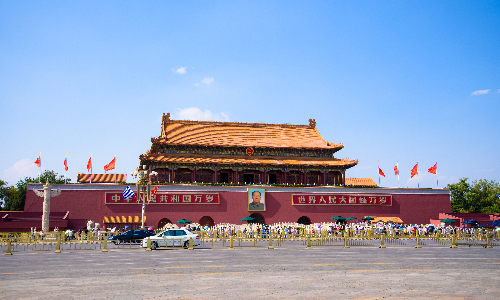

In the morning, we will go to the Chang Tomb of the Ming Tombs, 48 km away from downtown Beijing. Ming Tombs are the general name for the royal mausoleums of the 13 emperors in the Ming Dynasty. Built in 1409 and completed in 1645, the Ming Tombs cover an area of 40 square kilometers and are the largest surviving imperial tomb complex in China and the world, where the largest number of emperors and queens are buried. The Chang Tomb is the head tomb of the Ming Tombs, where Emperor Yongle and his empress were buried. The wall of the Chang Tomb was built on the mountain, with a total length of 12 kilometers. In the Chang Tomb, Ling’en Hall was a place where Emperor Yongle was memorized. It was built on a three-storey platform carved in white marble and paved with gold bricks. All wood pieces are made of antique golden nanmu. With a diameter of more than 1 meter and a height of more than 10 meters, 60 golden nanmu pillars support the lobby of the 2,300-square-meter Ling’en Hall, which is unique in the world. The largest golden nanmu is 12.58 meters high and 1.124 meters in diameter. It is a rare wood in the world.
In the afternoon, we will visit Mutianyu Great Wall which is 44.5 km away from the Chang Tomb. It will take us an hour and fifteen minutes to arrive there by car. Located in the northeast of the Chang Tomb, Mutianyu Great Wall is a section of the Great Wall built in the Ming Dynasty, with a length of 5, 400 meters. It was built in 1368 by General Xu Da on the site of the Great Wall of Northern Qi (550-577). It is the essence of the Ming Great Wall. This section is connected with Gubeikou in the east and Juyong Pass in the west. Since ancient times, it has been the military headquarter for the defense of the capital and its nearby areas. You will not be bothered to climb Mutianyu Great Wall, because we will provide you with round way cable car during your visit. Thus, you can focus on appreciating the beautiful scenery of both sides of the Great Wall.
Well, this is our last spot today. After that, your tour guide will send you to the hotel for a good rest.
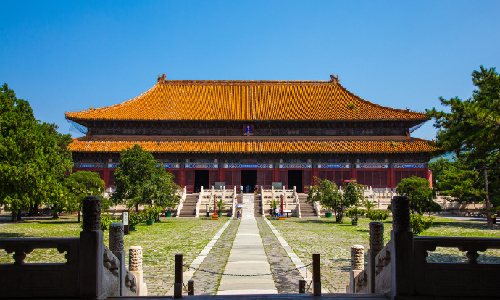

 Datong
Datong In the morning, your tour guide will send you to Beijing Train Station where you will take the estimated train G2503 08:10/09:56 to Datong. When reaching there, you will find your local tour guide waiting for you, waving a pick-up card with your name on it at the station. Then your guide will take you to the hotel.
In the afternoon, we will visit Yungang Grottoes which are located in the west of the Datong City of Shanxi Province. As one of the existing largest-scale ancient grottoes in China, it boasts 45 main caves as well as 51,000 stone statues. Yungang Grottoes are the first royal grottoes built on a large scale after Buddhism was introduced into China during the Han Dynasty (202 BC to 220 AD). Yungang Grottoes represent the highest level of world sculpture art in the 5th century. The Yungang Grottoes can be divided into the early, middle and late parts according to the time of excavation, and different periods of the grottoes have their own characteristics of the style of statues. In the early period, the grottoes are magnificent, with a vigorous, simple western feel. In the middle period, the grottoes are famous for their elaborate carving and ornate decoration, showing the complex, varied, and magnificent art style of the Northern Wei Dynasty (386-534). Although the grottoes in the late period are small in scale, the figures are slender and handsome, with moderate proportions, and are a model of grotto art in northern China.
Next, we will go to Huayan Temple which is in the west of Datong City, 18 kilometers away from Yungang Grottoes. Built in 1038, Huyan Temple covers 66,000 square meters. It is the largest surviving Liao (907-1125) and Jin (1115-1234) period Buddhist temple in China. There are many statues of the Liao Dynasty in the Huayan Temple, and the most famous one is the Bodhisattva, which was praised by Guo Moruo (a famous Chinese literatus) as the "Oriental Venus". There is a story about the bodhisattva. During the Liao Dynasty, the royal family believed in Buddhism and recruited skilled craftsmen to build the Huayan Temple. There was a skilled carver who did not want to work for the royal family and could not bear to leave his young daughter alone at home. This angered the government and the chief administrator beat him up for "disobeying the royal order". The craftsman was then forced to build the Huayan Temple. All the workers could not go home until the construction was finished. The craftsman missed his daughter very much. So, when he was building the statue of Bodhisattva, he carved one of the statues in the likeness of his daughter. His daughter was particularly fond of smiling, so he especially sculpted the look of smiling with her teeth on the statue. This is the most famous smiling Bodhisattva in Huayan Temple.
The last stop of today’s tour is the Nine Dragon Wall. There are three famous Nine Dragon Walls in China, one in Datong and the other two in Beijing and Pingyao. The Nine Dragon Wall in Datong is known as the most famous one of the Nine Dragon Walls in China. The Datong Nine Dragon Wall was built in the late Ming Dynasty, and is a wall in front of the residence of Prince Zhu Gui, the 13th son of Ming Emperor Zhu Yuanzhang. With a history of more than 600 years, the wall is 45.5 meters long, 8 meters high, and 2.02 meters thick, and is the earliest, tallest, largest, most majestic, and artistically charming of the three existing Nine Dragon Walls in China. The colors of the Nine Dragons Wall are gorgeous, such as peacock blue, green, yellow, medium yellow, light yellow, and purple. The whole wall is made of 426 pieces of specially made glazed components. There are 9 lively dragons on the wall. The lower part of the wall is a raging wave of lime green, and the upper part is blue fog and yellow flowing clouds. The dragons are connected by fogs, clouds, waves, cliffs, and water plants, which are colorful and spectacular.
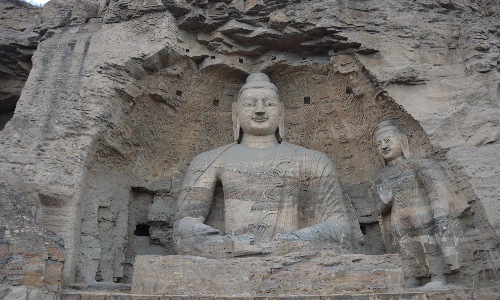

 Pingyao
Pingyao In the morning, your guide will send you to the train station where you will take the estimated Train D5363 07:45/11:25 to Pingyao. The moment you get off the train you will find a local guide waiting for you at the train station. Then your guide will take you to have lunch at a local restaurant.
In the afternoon, we will go to Pingyao Ancient Town which will amaze you during the China Ancient Town visit for students. Pingyao Ancient Town retains the basic features of the Ming and Qing Dynasties and is the most existed complete ancient town in China. In addition, it is also called Turtle City because its whole shape looks like a big turtle. The southern gate is regarded as the turtle’s head; the two wells outside the city gate are considered as the turtle’s eyes; the north gate is the tail; the four gates from east to west are four legs. The four streets, eight small streets, and 72 winding alleys in the city look like patterns on the back of a turtle. Moreover, there are various snacks in Pingyao Ancient Town, including sliced noodles, beggar’s chicken, Pingyao beef, fried cake, and so on. If you love noodles, you shall never miss the sliced noodles. The sliced noodles are famous for their craftsmanship. The noodles are cut into pieces by the skillful cook with a knife. The sliced noodles are thick in the medium part but thin in the edge, just looking like willow leaves. They are soft but not sticky in your mouth. The noodles with dipping sauce and vinegar will leave you an unforgettable impression. The production process of Pingyao beef is unique. It looks ruddy and tastes delicious.
After enjoying the scenery and snacks of Pingyao Ancient Town, you will be sent back to the hotel.
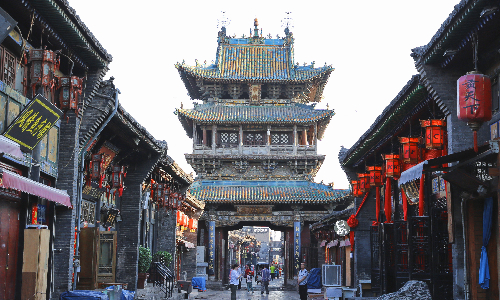
 Xi’an
Xi’an In the morning, your guide will send you to the train station to take the estimated Train D2505 08:40/11:49 to Xi’an. At Xi’an Train Station, you will be welcomed by the local guide who carries a pick-up card with your name on it. Then you will be sent to the hotel where lunch is offered.
In the afternoon, we will visit Xi’an City Wall which is the largest and best-preserved ancient city wall in China. The existing Xi’an City Wall is built in the Ming Dynasty, with a total length of 13.7 kilometers. The wall is 12 meters high, 12-14 meters wide at the top, and 15-18 meters wide at the bottom. Furthermore, the Xi’an City Wall has 18 gates, such as Zhuque Gate, Yongning Gate, Anding Gate, Anyuan Gate, and so on. Under the Zhuque Gate is Zhuque Street, the central axis of Chang’an(the ancient name of the Xi’an) during the Sui and Tang dynasties. The emperors held ceremonies here to welcome the victorious soldiers. Xuanzang (a monk in the Tang Dynasty who went to India for Buddhist scriptures) passed here to meet the emperor when he returned from his Buddhist pilgrimage. If you are too tired to walk, you could rent bikes on the Xi’an City Wall to enjoy the scenery of Xi’an City Wall.
Next, we will go to Muslim Street which is known for its delicacies and snacks. In the 1990s, a minority of Hui people (an ethnic minority of China) did catering business here. Thus, the street became a food court. Muslim Street is about 500 meters long from north to south, paved with stone slabs. On both sides of the street are buildings that imitate Ming and Qing architecture. The snacks and dishes are sold by the Hui people, with strong Muslim characteristics. There are all kinds of snacks and delicacies, such as soup dumplings, mutton and bread pieces in soup, syrup of plum, Rice and jujube cake, and so on. If you are keen on dessert, then the traditional Chinese dessert, the Rice and jujube cake, will surprise you. This kind of cake is made of sticky rice, candied dates, Ormosia, and raisins. All of those are steamed in a cauldron. It tastes sweet and sticky.
After visiting Muslim Street, we will visit the Great Mosque which is one of the most ancient Islamic temples in Xi’an. Built in 742, the Great Mosque covers 6,000 square meters. As a grand Chinese palatial ancient building cluster, it is the integration of Chinese culture and Islamic culture. Although the traditional Chinese architecture style is shown everywhere in the Great Mosque, the whole layout of the Great Mosque strictly obeys the Islamic system of worship. In terms of decoration, for example, Islam prohibits idolatry, so the buildings are usually decorated with plant and animal patterns. The Great Mosque is decorated with several dragons (In ancient China, dragons symbolize emperors), but the most decorative patterns are animals and plants. For instance, the brick sculpture of the front wall is a plant pattern. Besides, the pillars and walls of the worship hall are decorated with Koranic verse. All of those show strong Islamic features.
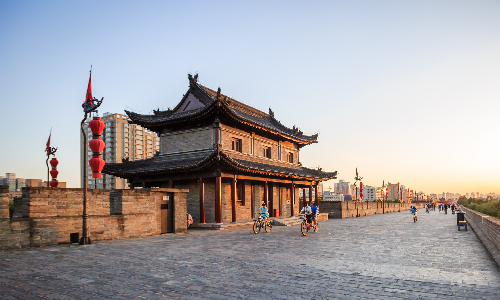
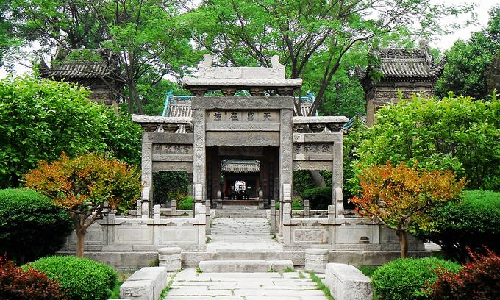
After breakfast, we will go to Terra Cotta Warriors and Horses Museum which is our fourth stop of Xi’an Student Tour. It will take us an hour to arrive there from the central area of Xi’an by car. Located in the northeast of downtown Xi’an, Terra Cotta Warriors and Horses are burial objects of tombs in ancient China. There are more than 8,000 Terra Cotta Warriors and Horses in total. It is said that Terra Cotta Warriors and Horses were found by accident when a peasant dug a well. When seeing those Terra Cotta Warriors and Horses, someone may ask why some Terra Cotta Warriors are complete while some are fragmentary. In fact, after more than 2,000 years buried underground, none of the Terra Cotta Warriors are intact. For scientific research and giving a visual display to tourists, it takes a lot of effort for restorers to put all the “pieces” of Terra Cotta Warriors back together again. Maybe it will take a tourist 3 seconds to watch a warrior, but it will take a restorer five months to restore a warrior!
In the afternoon, we will visit Small Wild Goose Pagoda (Closed on Tuesday) which is 45.8 km away from Terra Cotta Warriors and Horses Museum. It will take us an hour and fifteen minutes to arrive there by car. Small Wild Goose Pagoda is a typical work of a square brick pagoda with many eaves in early China. The pagoda originally had 15 storeys, but now there are only 13 storeys and a height of 43.4 meters. As a Buddhist architectural art heritage of the Tang Dynasty, it has become a landmark building since Buddhism was spread into China and integrated with Chinese culture. Small Wild Goose Pagoda was built to restore Buddhist scriptures and pictures brought from India by Yijing (a monk of the Tang Dynasty). There is an iron bell in the pagoda built in the Jin Dynasty. The iron bell is 8,000 kg, 3.55 meters tall. It was originally placed in a temple near the river bank which was later destroyed by a flood, so the bell was put in Small Wild Goose Pagoda where every morning, the temple bells regularly ring and can be heard from dozens of miles. What’s more, if you are interested in Chinese calligraphy, then you can join a calligraphy class here where you could learn some simple Chinese characters with a brush. The brush, Chinese art paper, and ink are provided here. After visiting Small Wild Goose Pagoda, your guide will send you to the hotel.


 Guilin
Guilin In the morning, your guide will send you to the airport where you need to take the estimated flight GS7683 08:55/11:00 to Guilin. Arriving there, you will find a guide waiting for you at the airport. Then you will have lunch at a local restaurant in the city area.
After lunch, your guide will take you to the Elephant Trunk Hill which lies at the convergence of Taohua River and Li River. The mountain is named for its resemblance to a giant elephant standing on the edge of the river with its trunk stretching out and drinking the water of the Li River. There is a legend about the Elephant Trunk Hill. A long time ago, the Jade Emperor of Heaven had a divine elephant. He often took the divine elephant with him to war. Once, during the battle, the divine elephant was injured to protect the Jade Emperor. The divine elephant was separated from the Jade Emperor and fainted in Guilin. The kind villagers in Guilin rescued the divine elephant and cured his wound. In order to repay the local people for saving his life, the divine elephant stayed behind to help the local villagers plow the fields and dredge the waterways. Later, the divine elephant turned his body into a hill and stayed forever in the Li River of Guilin, guarding the local people.
Next, you will visit Reed Flute Cave which is located in the northwest of Guilin. Reed Flute Cave is 240 meters deep and the tour distance is 500 meters. It is a place of interest where you can tour the cave and enjoy the pastoral scene. It is said that there is a kind of grass, called the reed, at the entrance of Reed Flute Cave that can be used to make flutes. The flute made of such grass can blow beautiful sounds. Thus, Reed Flute Cave gained its name. The formation of Reed Flute Cave has experienced a long history. A million years ago, this place was an ancient underground lake originally. Due to the crustal movement, the mountain was elevated and the water level dropped; thus, the lake turned into a cave. It is renowned as nature’s palace of art for its various grotesque stones, stalagmites, stalactites, and so on.
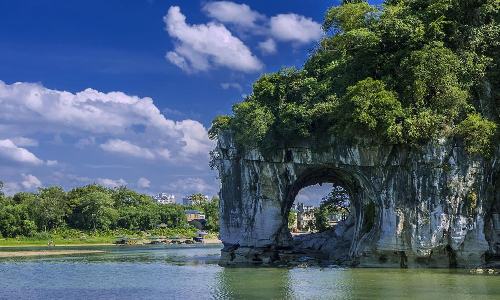
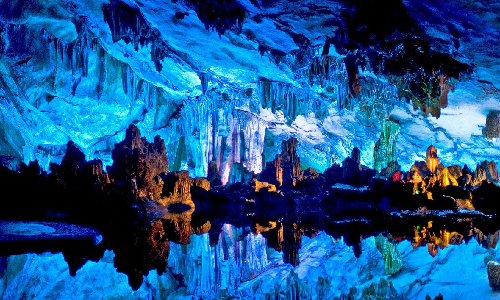
 Yangshuo
Yangshuo Guilin
Guilin In the morning, you will go to Mopanshan pier which is 24 km away from the center of Guilin. We will spend 30 minutes arriving there by car. After reaching Mopanshan pier, you will take the three-star Li River Cruise Ship. And then, our student tour to Li River will begin. It will take us 4 hours on the Li River Cruise Ship where lunch is offered.
Li River is the largest and most beautiful karst landscape tourist area in the world. The features of Li River can be summarized as four words: clear, peculiar, marvelous, and ever-changing. Li River is quite clear as a crystal all year round. The mountains on both sides of the Li River are peculiar and beautiful. Many of them look like various animals and humans. In addition, the scenery of Li River always changes with the season, day and night, and the weather. Especially in the drizzly morning, fog and rain envelop the mountains that are vaguely visible in the mist. The most characteristic scene is Cormorant Fishing. If you are lucky enough, you can see that on the Li River during the cruise.
Getting to Yangshuo, we will visit Yangshuo West Street which is a pedestrian street. Over 1,400 years, Yangshuo West Street has been the most ancient and busiest street in Yangshuo Old Town. It is 800 meters long and 8 meters wide, paved with marbles. On both sides are tile-houses built with bricks of the Qing Dynasty, with white walls and red windows, showing the simplicity and elegance of the local architecture. Besides, there are various delicacies on Yangshuo West Street, including beer fish, and osmanthus cake. The beer fish is a famous specialty, which is cooked with fish caught in Li River, beer, shredded ginger, soy sauce, and pepper. When cooking the dish, the fish is cut into two pieces without scraping the scales and is fried with shredded ginger for a few minutes. Until the scales turn yellow and roll up, then the cook will pour the soy sauce on it, sprinkle the red pepper, pour half a bottle of beer, cover the pot, and braise it. If you like eating fish, you should definitely try this dish. As a traditional Chinese dessert, osmanthus cake is cooked with glutinous rice flour, sugar, and osmanthus. If you love the desert, this kind of Chinese dessert will amaze you.
After visiting Yangshuo West Street, the driver will drive you north to Guilin. It will take us 1.5 hours to return to Guilin since it is 70 km away.

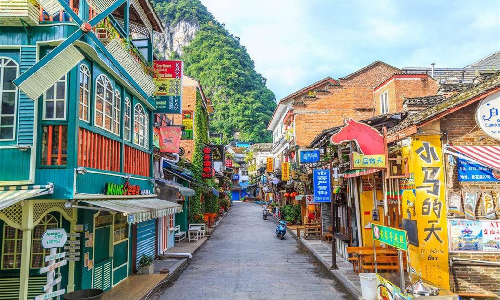
 Hong Kong
Hong Kong In the morning, we will go to Sun and Moon Twin Pagodas of which the Sun Pagoda is the tallest bronze pagoda in the world. The Sun Pagoda has 9 storeys in total, with a height of 41 meters, decorated with bronze. It is built with 350 tons of bronze and equipped with an elevator for tourists’ convenience. There is a bronze bell on the first floor. On the second floor, there is a tea shop where tourists can enjoy the fabulous scenery while drinking tea. Getting to the top of the Sun Pagoda by elevator, you can overlook the mountains and Li River. At the underground palace of the Sun Pagoda, there are sacred Sakyamuni Statue, Eleven Bronze Statues of Avalokitesvara, Buddhist bronze relics with different expressions, and the colorful and mysterious Thangka. The Moon Pagoda has 7 storeys, with a height of 35 meters, built with colored glaze. It is connected to the Sun Pagoda by a 10-meter-long tunnel at the bottom of the lake. The tunnel is equipped with arched glass, through which you can see the beautiful small fish and water plants at the bottom of the lake.
Next, we will visit Two Rivers and Four Lakes which include Li River, Taohua River, Gui Lake, Mulong Lake, Shan Lake (In Chinese, Shan means cedars), and Rong Lake (In Chinese, Rong means banyans). The total length of the water system around the city is 7.33 kilometers, with a surface area of 385,900 square meters. In the center of Guilin City is a giant lake which is divided by a bridge. On the east of the bridge is Shan Lake which is famous for cedars on its sides. On the west of the bridge is Rong Lake which is known for banyans on its sides.
After lunch, your guide will send you to the train station where you will take the estimated Train G410 13:36/16:57 to Hong Kong West Kowloon. Reaching Hong Kong, your local guide with a pick-up card is waiting for you at the train station. Then your guide will send you to the hotel for a good rest.
In the afternoon, the first stop of the Hong Kong student tour is Star Avenue, which is on the Kowloon Island of Hong Kong. Located in the Tsim Sha Tsui Promenade, Star Avenue is built to praise outstanding celebrities in Hong Kong filmdom. Many celebrities’ names and palm prints are inlaid on the special commemorative plaques placed on Star Avenue chronologically. In addition, there are also many statues of famous Hong Kong artists and film stars on Star Avenue for visitors to take photos of. On November 27, 2005, a bronze statue of martial arts superstar Bruce Lee was unveiled on Hong Kong’s Star Avenue. The statue, two meters high, was built in the shape of Bruce Lee's character in the movie “Enter the Dragon” to commemorate his 65th birthday.
Then our next destination is Nathan Road. As one of the most famous streets in Hong Kong, the relay of the Beijing Olympic Torch began here. Moreover, there are numerous top brand stores on the roadside where you can enjoy your shopping. There are also snack bars everywhere. If you are interested in Hong Kong food, then you can choose one to enjoy.
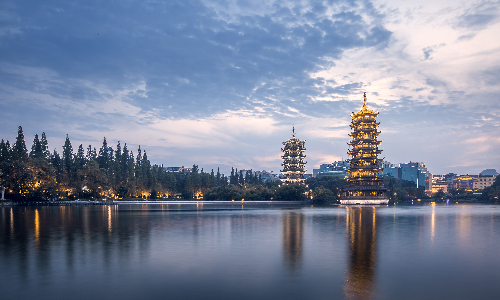

In the morning, we will go to Nanlian Garden which was built in 2003, covering 35,000 square meters. It is an old-fashioned garden that exists like an oasis in the middle of the downtown. To visit the Nanlian Garden, you can stroll along a one-way backtracking path in the garden. The trees, stone scenery and ancient buildings are like a landscape scroll unfolding before your eyes. There is a souvenir store, vegetarian restaurant, teahouse and multifunctional activity room for the public to visit and use in the Nanlian Garden. When you are tired, you can take a break in the Garden and feel the strong natural and cultural atmosphere while resting.
Next to the Nanlian Garden, there is our next destination – Chilin Nunnery, which was built in 1936, covering an area of over 30,000 square meters. It is composed of three courtyards. Walking into the front gate, you will see four lotus ponds filled with blooming lotus, which represents a pure land in the mortal world. Standing on the second yard is the Hall of the Celestial Kings, bell towers, and drum towers which are located in the central area of the temple. A large number of Buddhist precious cultural relics of the sutra and dharma hall are restored in the third yard.
Then we will take the Peak Tram to Victoria Peak which combines sightseeing, entertainment, and shopping. Not only can you enjoy the fabulous scenery, but also experience modern recreation. When you take the Peak Tram, you will see the phenomenon of skyscrapers tilting. Why? A scholar of the psychology department at Hong Kong University conducted an experiment on the Peak Tram. Surveys have shown that when passengers take the Peak Tram to Victoria Peak, if they look out of the window, they often have the illusion that the surrounding buildings are all tilted. When you sit in the cabin of the Peak Tram, your body could not help leaning back. The slope of some sections ranged from 4 to 25.7 degrees! Getting to the peak, your guide will lead you to Peak Tower. Then you can go to the Sky Terrace 428 to appreciate the marvelous scenery of the Hong Kong Island and Victoria Harbor.
Next, you will go to Repulse Bay which is located in the south of Victoria Peak on Hong Kong Island. It is a crescent-shaped bay, known as the “first bay under the world”. Repulse Bay is calm all year round. What surprises you is the Tin Hau Temple at the back of Repulse Bay. The temple seems to cover a small area, but there are Mazu, Avalokitesvara, and many prayer tablets. In the past, people believed that these Goddess could protect fishermen from bad weather and waves when they were at the sea. So, they often came here to worship. This habit continues to the present. Although the people who live near Repulse Bay now no longer make their living by fishing, people still often come to worship Mazu for good luck and health.
Afterward, we will visit Stanley Market which is in the southeast of Hong Kong Island. There are many buildings modeled after the Tang Dynasty architecture, selling a variety of snacks, clothing, souvenirs and handicrafts. Not only can you enjoy the leisure time, but also experience the pleasure of bargaining with the shoppers.


After breakfast, we will go to Lantau Island. Firstly, we will drive to Ngong Ping where we will take Ngong Ping 360 Cable Car to Ngong Ping Village. Then we will visit Po Lin Monastery which was built in 1906. Before it was being built, three Buddhist masters visited here. They pleasantly found a vast plain at the peak of the mountain on Lantau Island. Although this plain is covered with thorns and weeds and off the beaten path, it is quiet, which makes it an ideal place to practice Buddhism. Thus, they made efforts to build a stone chamber which attracted a lot of monks to come and stay. Since then, the stone chamber gradually developed into a temple which is Po Lin Monastery today.
Afterward, you will visit the Big Buddha which stands on the top of Lantau Island. As the highest bronze Buddha, it is 26 meters high and 220 tons in weight, built with 200 bronze parts. The big Buddha sits on the lotus flower. His face is so round that is like a full moon with a broad and flat forehead, which reveals the Buddha’s full blessing and wisdom. The palm of his left hand is turned outward, and the fingers are slightly downward. The posture is called “gesture of blessing”, which contains the blessing and kindness to all living beings. After visiting the Big Buddha, your guide will send you to the hotel.

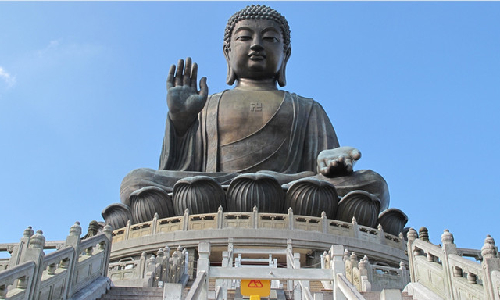
Today, it is time to say goodbye, and your guide will send you to the airport. Wish you have had an impressive journey.
Author: Wang Chongchong
Proofreader: Lexie
| City | Five Star hotel list | Four Star hotel list |
|---|---|---|
| Beijing | Sunworld Dynasty Hotel Beijing Wangfujing | Sunworld Hotel Wangfujing |
| Datong | Yungang Meigao Hotel | Datong Garden Hotel |
| Pingyao | Pingyao Yide Hotel | Pingyao Dejuyuan Guesthouse |
| Xi'an | Tianyu Gloria Grand Hotel Xi'an | Sunworld Dynasty Hotel |
| Guilin | Lijiang Waterfall Hotel | Guilin Bravo Hotel |
| Hong Kong | Harbour Grand Kowloon | Harbour Plaza North Point Hotel |
 |
![]() About your child or infant, please contact us for a discounted price.
About your child or infant, please contact us for a discounted price.



We started with a few days in Beijing & ended in Shanghai, from where we visited the Forbidden City and Great Wall. In between we visited Terra Cotta Warriors Museum, Panda Base, Shanghai Disneyland.

We had a wonderful holiday in China which will remain long in the memory. China is a breathtakingly beautiful country full of splendid temples and palaces, mountains and rivers, peaceful rural scenes and bustling shopping streets.
 QUICK ENQUIRY
QUICK ENQUIRY